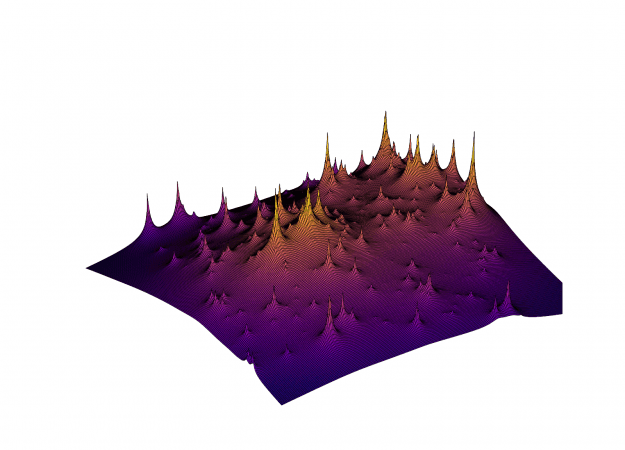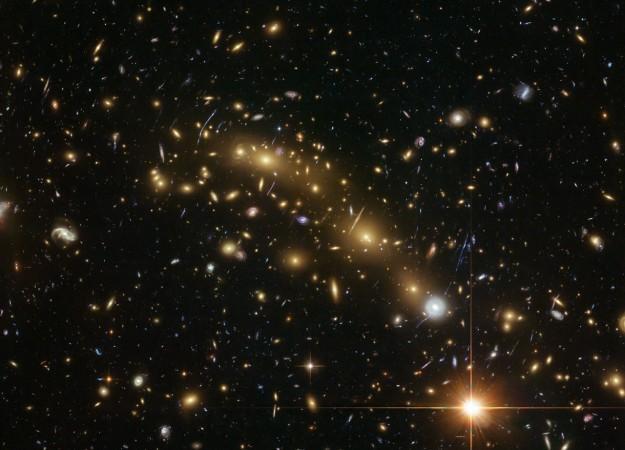These are some of the darkest mysteries of our universe
This is the Hubble Space Telescope Image of a Frontier Fields galaxy cluster, Abell 2744 (one of the deepest images taken of any cluster in the universe).
Both philosophers and scientists are captivated by the concept of dark matter, dark energy and black holes.
“Human beings by nature have always been intrigued by the invisible,” says astrophysicist Priyamvada Natarajan, author of "Mapping the Heavens."
Natarajan is a theoretical astrophysicist, a professor of physics and astronomy at Yale University. She's also spent much of her academic career studying philosophy.
“I think the philosophical angle helps to sort of keep everything in perspective,” Natarajan says. “I find it much more comfortable to deal with these sort of cosmic scales — you know, talking about 3.5 billion years, a process taking a hundred million years — all of that is somehow much more comprehensible to me than, you know, day-to-day life stuff. So I think being philosophical has been very helpful.”
Natarajan is working to make a map of the unseen dark matter of the universe, using the gravitational bending of light to map the lumps and smears of dark matter throughout the universe. She hopes that studying the overlapping of filaments of dark matter on her maps can give us clues to where and why galaxies form.

“The goal is, since we haven't detected the dark matter particle directly yet, we're really looking for indirect clues on what it might be, and I think that's what gravitational lensing can provide,” Natarajan says.
Her gravitational lensing technique involves exploiting the bending of light that mass generates. Dark matter is everywhere in the universe, but Natarajan says it clumps in certain places. And because scientists know the shape distributions of galaxies on average, they can locate distortions in some galaxies. Those distortions and deflections in light from distant galaxies, Natarajan thinks, are key to finding dark matter.
“Essentially what happens is … if you started with circular galaxies, they would get stretched out, and they would look like little ellipses and they could be quite dramatically stretched out if there's a lot of dark matter along the line of sight to us,” Natarajan says.
Dark matter is not the only mystery that fascinates philosophers and scientists. Black holes are another source of inspiration and unknown.
“Philosophers get very interested about black holes,” says astrophysicist and director of the Event Horizon Telescope Project, Shep Doeleman, “If you talk to them about stars they say they're beautiful — even neutron stars, they say they're wacky. But when you talk to them about black holes, they get dreamy and they get very interested because this is an area of space-time that is unaccessible to us. And that really is very very startling and spooky.
"Our whole worldview is based on Newtonian determinism that if you know what is happening around you, you can propagate it forward in time and know where you're going to be later. But what if you're falling into a black hole and you can't tell somebody what happened to you? Is that part of it? Is that determinism or not? Or does determinism break down so black holes, in addition to the information theory problem, they strike at the core of some of western thought.”
Doeleman is hoping to learn more about black holes by capturing the first-ever picture of one of them. His Event Horizon Telescope, a global network of radio telescopes creating a virtual satellite dish the diameter of Earth, may be the thing to capture it.
“Black holes are, by definition, something you can't see,” Doeleman says. “They are the tiniest things you can imagine. They are the end result of gravity going haywire and collapsing a bunch of matter into a point source. But around that point is this wonderful membrane called the event horizon and that's the point where the gravity is so intense that even light can't escape … So all this gas and dust around the black hole is madly trying to get into a very small volume and in a cosmic traffic jam it heats up to billions of degrees. So black holes can be some of the brightest things that we see in the sky.”
Doeleman has been searching the skies for a ring of light that should, theoretically, be found in a certain size and shape around a black hole.
“What we're looking for is this ring of light and if it's the right size, let’s say around the 4 million solar mass black hole at the center of our galaxy, the Milky Way, then that would tighten the noose incredibly. So in the center of our galaxy, there’s this large black hole and some wonderful groups … have seen stars orbiting around this unseen mass.
"And that is very powerful evidence that it's a black hole … We, our global team … are getting ready to take our first potential imaging data [of the black hole] in the spring of 2017. That's when we'll add sites at the South Pole, in Chile, Hawaii, Arizona, Mexico, France and Spain … to look at this exotic object.”
This article is based on an interview that aired on PRI's Science Friday.
